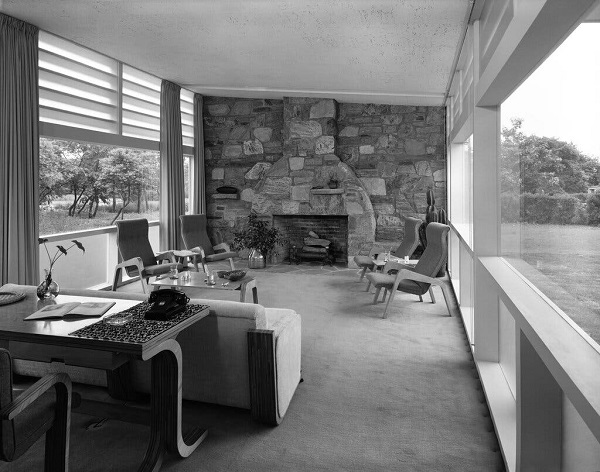The best of suburbia

"LAWRENCE, N.Y. – The Geller house embodied the optimistic, now-vanished values of postwar suburbia: technological progress and a lifestyle built around children's needs. Marcel Breuer's Geller House, 1945, was emblematic of the greater informality families sought." (James S. Russell, "Why Does the Demolition of a Marcel Breuer House Matter?", NYT, +2022.02.06)
My wife's maternal grandfather, Sidney Goldstone, was a modernist architect. There is a picture of him looking somewhat like Bertolt Brecht, including the wire-rim glasses. He designed 40 Wall Street. He had two daughters.
Sidney designed a house for the other daughter that is a paradigmatic early post-World War II modernist suburban house. Not the Levittown suburbs, but the upper iddle class. I may have heard the house cost $115,000 when a Levittown house may ahve been $8,000. It is not in a "development, but in an established "neighborhood", where most of the houses are traditional of one sort of another. It was a "one off". The living ro om is bigger and even more "open" than the above (in part because of a higher ceiling), but he spirit is similar; Light, light, light. Bright sunlight, open space, blonde wood built-in storage units. The house looks fresh still today, or at least the one time I saw it some years ago. The kitchen is small. but the family was not much into eating. The sister's husband was an afficionado of early 20th Century Jazz music and much of the basement was a meticulously organized warehouse for the CDs he produced and sold. His music collection was museum quality; obviously, he did not have to work hard, and then not at all ("the mills").
Let me call this house "World House", which is partly anesoteric pun and partly a reference to universal humanistic values in arts and crafts. The whole house is light. Ther is open space everywhere. Clutter would be out of place in any place in the house, and everything doe sindeed look like the house is ready for an "Open house", i.e., for sale. Partly this can be attributed to the kids all having grown up adn moved out so that their rooms, one "made", stay made, except for occasional visits. The place could have used with some bookcases and books to in-form everybody's minds, but it is what it is, and nobody is offering me to live there.
I guess there are television sets in the bedrooms, but the stereo [audio playback] system was the media for the living room. This family was not Loving Lucy even though they also were not studying "The an Without Qualities". They were somewhere in the middle. If what they had, their life with 2 BMW 5 Series and a tennis court at the bottom of the property, and enough trees to not be able to see the neighbors, suburbia is not so bad, is it? Bu tthis does not work for the many all too many, and, giving credit where credit is due, the lady of the house made her contribution to the population explosion, producing 3 children, not stopping at 1.
Goodburbia simply could not work on a small planet with a lot of people on it. The same thing applies to Frank Lloyd Wright's "prairie houses" / Usonian fantasies. The American Dream could never have worked because there wer too many people, but it never got to the point of failing from the top; it failed from the bottom. Quality, even in moderation, costs more than prefab mass production for a mass-market.
But one can still look at a post-World War II modernist suburban house and see that not all Americans' imaginative horizon was bounded by the dude-ranch house. These people had a lawn but I cannot imagine the father wasting his time mowing it when he had museum quality Jazz to produce. Not my kind of music, but not just listening passively "Old Blue Eyes", either. If I have the man's money I would hav been schmoozing with Wanda Landowska, but the fact remains that he was creating something of value, not just being a consumer of consumer products, or, with his modest wealth, buying an occasional Tiffany trinket for his Mary Hartmann, Mary Hartmann and the waxy yellow buildup on her kitchen floor.
 Welcome
Welcome \
\
